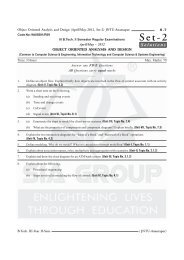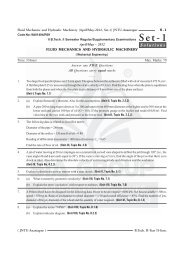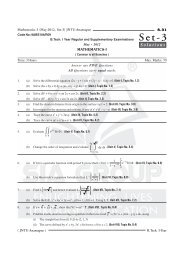Set-1 Final by Ali (1-9) (R).p65 - SIA GROUP
Set-1 Final by Ali (1-9) (R).p65 - SIA GROUP
Set-1 Final by Ali (1-9) (R).p65 - SIA GROUP
Create successful ePaper yourself
Turn your PDF publications into a flip-book with our unique Google optimized e-Paper software.
Probability Theory and Stochastic Processes (May-2012, <strong>Set</strong>-1) JNTU-Kakinada<br />
Code No: R21043/R10<br />
II B.Tech. I Semester Supplementary Examinations<br />
May - 2012<br />
PROBABILITY THEORY AND STOCHASTIC PROCESSES<br />
( Electronics and Communications Engineering )<br />
WARNING : Xerox/Photocopying of this book is a CRIMINAL act. Anyone found guilty is LIABLE to face LEGAL proceedings.<br />
S.1<br />
Time: 3 Hours Max. Marks: 75<br />
Answer any FIVE Questions<br />
All Questions carry equal marks<br />
- - -<br />
1. (a) A survey of 100 companies shows that 75 of them have installed wireless local area network (WLANS) on their<br />
premises. If three of these companies are chosen at random without replacement, what is the probability that<br />
each of the three has installed WLANS. (Unit-I, Topic No. 1.4)<br />
(b) State and prove the Baye’s theorem. [8+7] (Unit-I, Topic No. 1.5)<br />
⎧ x<br />
⎪<br />
2. (a) The PDF of a random variable X is given <strong>by</strong> f x<br />
(x) = ⎨2<br />
− x<br />
⎪<br />
⎩ 0<br />
(i) Find the CDF of X<br />
(ii) Find P [0.2 < X < 0.8]<br />
(iii) Find P [0.6 < X < 1.2] (Unit-II, Topic No. 2.2)<br />
0 < x < 1<br />
1 ≤ x ≤ 2<br />
otherwise<br />
(b) Write short notes on “Gaussian distribution”. [8+7] (Unit-II, Topic No. 2.3)<br />
3. (a) The PDF of a random variable X is given <strong>by</strong> f x<br />
(x) = 4x(9 – x 2 )/ 81 0 ≤ x ≤ 3. Find the mean, variance and third<br />
moment of X. (Unit-III, Topic No. 3.3)<br />
⎧1<br />
⎪<br />
(b) The random variable X has the following PDF f x<br />
(x) = ⎨3<br />
⎪⎩ 0<br />
−1<br />
< x < 2<br />
Otherwise<br />
If we desire Y = 2X + 3, what is the PDF of Y. [7+8] (Unit-III, Topic No. 3.4)<br />
4. (a)<br />
2 2<br />
Two random variables X and Y have zero mean and variance σ x<br />
= 16 and σ y = 36. If their correlation<br />
coefficient is 0.5 determine the following,<br />
(i) The variance of the sum of X and Y<br />
(ii) The variance of the difference of X and Y. (Unit-IV, Topic No. 4.3)<br />
(b) State and prove the ‘Central limit theorem’. [8+7] (Unit-IV, Topic No. 4.4)<br />
⎧ 1<br />
⎪<br />
24<br />
5. (a) A joint probability density function is f xy<br />
(x, y) = ⎨<br />
⎪ 0<br />
⎪<br />
⎩<br />
(b)<br />
0 < x < 6<br />
0 < y < 4<br />
elsewhere<br />
Find out the expected value of the function g(X, Y) = (XY) 2 . (Unit-V, Topic No. 5.1)<br />
<strong>Set</strong>-1<br />
Solutions<br />
Prove that the moment generating function of the sum of two independent variables is the product of their<br />
moment generating function. [8+7] (Unit-V, Topic No. 5.1)
S.2 Spectrum ALL-IN-ONE Journal for Engineering Students, 2012<br />
6. (a) Explain the following,<br />
(i) Stationarity<br />
(ii) Ergodicity<br />
(iii) Statistical independence with respect to random processes. (Unit-VI, Topic No. 6.4)<br />
(b) State and prove the properties of cross correlation function. [8+7] (Unit-VI, Topic No. 6.5)<br />
7. (a) A random process Y(t) has the power spectral density S YY<br />
(ω) =<br />
Find,<br />
(i) The average power of the process<br />
(ii) The auto correlation function. (Unit-VII, Topic No. 7.1)<br />
9<br />
ω 2 + 64<br />
(b) State the properties of power spectral density. [8+7] (Unit-VII, Topic No. 7.1)<br />
8. Write short notes on the following,<br />
(i) Thermal noise (Unit-VIII, Topic No. 8.5)<br />
(ii) Effective noise temperature. [7+8] (Unit-VIII, Topic No. 8.5)<br />
WARNING : Xerox/Photocopying of this book is a CRIMINAL act. Anyone found guilty is LIABLE to face LEGAL proceedings.
Probability Theory and Stochastic Processes (May-2012, <strong>Set</strong>-1) JNTU-Kakinada<br />
S.3<br />
SOLUTIONS TO MAY-2012, SET-1, QP<br />
Q1. (a) A survey of 100 companies shows that<br />
75 of them have installed wireless local<br />
area network (WLANS) on their premises.<br />
If three of these companies are chosen<br />
at random without replacement, what is<br />
the probability that each of the three has<br />
installed WLANS.<br />
Answer :<br />
May-12, <strong>Set</strong>-1, Q1(a) M[8]<br />
Given that,<br />
In a survey,<br />
Total number of companies = 100<br />
Number of WLAN installed companies = 75<br />
Number of WLAN installed companies chosen at<br />
random without replacement = 3<br />
P(All the three WLAN installed companies) = <br />
Let A be the event of selecting first company that<br />
installed WLAN.<br />
Then, the probability of A is given <strong>by</strong>,<br />
P(A)=<br />
Number of<br />
75c<br />
=<br />
100<br />
75<br />
= 100<br />
1<br />
c1<br />
∴ P( A)<br />
= 0.75<br />
companies installed WLAN<br />
companies<br />
Total number of<br />
Now, the total number of companies remained = 99<br />
Number of WLAN installed companies remained = 74<br />
Let B be the event of selecting second company that<br />
installed WLAN.<br />
Then, the probability of selecting B after selecting A<br />
is given <strong>by</strong>,<br />
P(B)=<br />
74<br />
99<br />
c1<br />
c1<br />
74<br />
= = 0.7475 99<br />
∴ P( B)<br />
= 0.7475<br />
Now,<br />
The total number of companies remained = 98<br />
Number of WLAN installed companies remained = 73<br />
Let C be the event of selecting third company that<br />
installed WLAN.<br />
Then, the probability of selecting C after selecting A<br />
and B is given <strong>by</strong>,<br />
73c1<br />
P(C) =<br />
98<br />
c1<br />
73<br />
= = 0.7449 98<br />
∴ P( C)<br />
= 0. 7449<br />
∴ The probability that all the three companies have<br />
installed WLAN is given <strong>by</strong>,<br />
P(A ∩ B ∩ C) = P(A) P(B) P(C)<br />
[Q Selection of companies A, B and<br />
C is independent to each other]<br />
= 0.7449 × 0.7475 × 0.75<br />
= 0.4176<br />
∴ P( A ∩ B ∩C)<br />
= 0.4176<br />
(b) State and prove the Baye’s theorem.<br />
Answer :<br />
May-12, <strong>Set</strong>-1, Q1(b) M[7]<br />
For answer refer Unit-I, Q23.<br />
Q2. (a) The PDF of a random variable X is given<br />
⎧ x<br />
⎪<br />
<strong>by</strong> f x<br />
(x) = ⎨2<br />
− x<br />
⎪<br />
⎩ 0<br />
(i)<br />
Find the CDF of X<br />
0 < x < 1<br />
1≤<br />
x ≤ 2<br />
otherwise<br />
(ii) Find P[0.2 < X < 0.8]<br />
(iii) Find P[0.6 < X < 1.2]<br />
Answer :<br />
May-12, <strong>Set</strong>-1, Q2(a) M[8]<br />
The given probability density function of a random<br />
variable ‘X’ is,<br />
⎧ x<br />
⎪<br />
F X<br />
(x) = ⎨ 2 − x<br />
⎪⎩<br />
0<br />
0 < x < 1<br />
1 ≤ x ≤ 2<br />
Otherwise<br />
WARNING : Xerox/Photocopying of this book is a CRIMINAL act. Anyone found guilty is LIABLE to face LEGAL proceedings.
S.4 Spectrum ALL-IN-ONE Journal for Engineering Students, 2012<br />
(i)<br />
(i) CDF of X, F X<br />
(x) = <br />
(ii) P(0.2 < X < 0.8) = <br />
(ii) P(0.6 < X < 1.2) = <br />
The cumulative distributive function of ‘X’ is given<br />
<strong>by</strong>,<br />
∞<br />
F X<br />
(x) = ∫<br />
f X ( x)<br />
dx<br />
−∞<br />
1<br />
=<br />
∫xdx<br />
+<br />
∫<br />
2 −<br />
0<br />
1<br />
⎡<br />
2<br />
x<br />
=<br />
2 ⎥ ⎥ ⎤<br />
⎢<br />
⎢⎣<br />
⎦<br />
0<br />
2<br />
1<br />
( x)<br />
dx<br />
+ 2 [] x 2 1 –<br />
⎡<br />
2<br />
x<br />
2 ⎥ ⎥ ⎤<br />
⎢<br />
⎢⎣<br />
⎦<br />
⎡1 2 − 0⎤<br />
⎡2<br />
= ⎢ ⎥ + 2 [2 – 1] – ⎢<br />
⎢⎣<br />
2 ⎥⎦<br />
⎢⎣<br />
1 ⎡ 4 −1⎤<br />
= + 2 [1] – ⎢ ⎥⎦ 2 ⎣ 2<br />
2<br />
1<br />
2<br />
−<br />
2<br />
2<br />
1 ⎤<br />
⎥<br />
⎥⎦<br />
(iii)<br />
0.64<br />
− 0.04<br />
=<br />
2<br />
= 0.6/2<br />
= 0.3<br />
∴ P( 0.2 < X < 0.8 = 0.3<br />
The value of P(0.6 < X < 1.2) is obtained as,<br />
1. 2<br />
P(0.6 < X < 1.2) = ∫<br />
0.6<br />
1<br />
f X<br />
( x)<br />
dx<br />
= ∫<br />
f X x)<br />
dx +<br />
∫<br />
0.6<br />
1<br />
1.2<br />
( f ( x)<br />
dx<br />
=<br />
∫xdx<br />
+<br />
∫<br />
2 −<br />
0.6<br />
1<br />
⎡<br />
2<br />
x<br />
=<br />
2 ⎥ ⎥ ⎤<br />
⎢<br />
⎢⎣<br />
⎦<br />
0.6<br />
1.2<br />
1<br />
1<br />
X<br />
( x)<br />
dx<br />
⎡<br />
2<br />
1. 2<br />
x<br />
+ 2 [x] 1<br />
–<br />
2 ⎥ ⎥ ⎤<br />
⎢<br />
⎢⎣<br />
⎦<br />
1.2<br />
1<br />
(ii)<br />
∴<br />
F X<br />
= 2<br />
1 + 2 + 2<br />
3<br />
1 + 4 + 3<br />
=<br />
2<br />
= 2<br />
8<br />
= 4<br />
( x)<br />
= 4<br />
The value of P(0.2 < X < 0.8) is obtained as,<br />
0.8<br />
P(0.2 < X < 0.8) = ∫<br />
0.2<br />
f X<br />
0<br />
= ∫ . 8<br />
xdx<br />
0. 2<br />
⎡<br />
2<br />
x<br />
=<br />
2 ⎥ ⎥ ⎤<br />
⎢<br />
⎢⎣<br />
⎦<br />
( x)<br />
dx<br />
0.8<br />
0.2<br />
⎡<br />
2 2<br />
1 − (0.6) ⎤<br />
⎡<br />
2 2<br />
(1.2) −1<br />
⎤<br />
= ⎢ ⎥ + 2 [1.2– 1] – ⎢ ⎥<br />
⎢⎣<br />
2 ⎥⎦<br />
⎢⎣<br />
2 ⎥⎦<br />
⎡1−<br />
0.36⎤<br />
⎡1.44<br />
−1⎤<br />
= ⎢ ⎥ + 2 (0.2) –<br />
⎣ 2<br />
⎢ ⎥ ⎦ ⎣ 2 ⎦<br />
=<br />
0.64<br />
2<br />
∴ P( 0.6 < X < 1.2) = 0.5<br />
+ 0.4 –<br />
= 0.32 + 0.4 – 0.22<br />
= 0.5<br />
0.44<br />
2<br />
(b) Write short notes on “Gaussian distribution”.<br />
Answer :<br />
May-12, <strong>Set</strong>-1, Q2(b) M[7]<br />
For answer refer Unit-II, Q20.<br />
Q3. (a) The PDF of a random variable X is given<br />
<strong>by</strong> f x<br />
(x) = 4x(9 – x 2 )/ 81 0 ≤ x ≤ 3. Find the<br />
mean, variance and third moment of X.<br />
Answer :<br />
May-12, <strong>Set</strong>-1, Q3(a) M[7]<br />
The given probability density function of a random<br />
variable ‘X’ is,<br />
=<br />
(0.8)<br />
2 −<br />
(0.2)<br />
2<br />
2<br />
f X<br />
(x) =<br />
2<br />
4x(9<br />
− x )<br />
, 0 ≤ x ≤ 3<br />
81<br />
WARNING : Xerox/Photocopying of this book is a CRIMINAL act. Anyone found guilty is LIABLE to face LEGAL proceedings.
Probability Theory and Stochastic Processes (May-2012, <strong>Set</strong>-1) JNTU-Kakinada<br />
Mean, E[X] = <br />
Consider,<br />
2<br />
Variance, σ X<br />
= <br />
∞<br />
Third moment of X, E[X 3 E[X 2 2<br />
]=<br />
] = <br />
∫<br />
x f X ( x)<br />
dx<br />
−∞<br />
The mean of random variable ‘X’ is given <strong>by</strong>,<br />
3<br />
2<br />
∞<br />
2 4x(9<br />
− x )<br />
=<br />
E[X] = ∫<br />
xf X ( x)<br />
dx<br />
∫<br />
x<br />
dx<br />
81<br />
0<br />
−∞<br />
3<br />
3<br />
2<br />
4 3 5<br />
x x<br />
= ∫ x 4 (9 − )<br />
=<br />
dx<br />
81<br />
∫<br />
( 9x<br />
− x ) dx<br />
81<br />
0<br />
0<br />
= 4 3<br />
⎧<br />
3 3<br />
⎫<br />
4 ⎪ ⎡<br />
4<br />
⎤ ⎡<br />
6<br />
x x ⎤ ⎪<br />
2 2<br />
81<br />
∫<br />
x ( 9 − x ) dx<br />
= ⎨9⎢<br />
⎥ − ⎢ ⎥ ⎬<br />
81 ⎢<br />
0<br />
⎪⎩ ⎣ 4 ⎥⎦<br />
⎢⎣<br />
6<br />
0<br />
⎥⎦<br />
0 ⎪⎭<br />
= 4 3<br />
4<br />
2 4<br />
⎪⎧<br />
⎛<br />
4<br />
⎞ ⎛<br />
6<br />
⎞⎪⎫<br />
81<br />
∫<br />
( 9x<br />
− x ) dx<br />
= ⎨ ⎜<br />
3 − 0<br />
⎟ ⎜<br />
3 − 0<br />
9 − ⎟<br />
81<br />
⎬<br />
0<br />
⎪⎩ ⎝ 4 ⎠ ⎝ 6 ⎠⎪⎭<br />
⎧<br />
3 3<br />
⎫<br />
4 ⎪ ⎡<br />
3<br />
⎤ ⎡<br />
5<br />
4 ⎧ ⎛ 81⎞<br />
⎛ 729 ⎞⎫<br />
x x ⎤ ⎪<br />
= ⎨9⎜<br />
⎟ − ⎜ ⎟⎬<br />
= ⎨9⎢<br />
⎥ − ⎢ ⎥ ⎬<br />
81 ⎩ ⎝ 4 ⎠ ⎝ 6 ⎠⎭<br />
81 ⎢ ⎥ ⎢ ⎥<br />
⎪⎩ ⎣ 3 ⎦0<br />
⎣ 5 ⎦ 0 ⎪⎭<br />
4 81 4 729<br />
= × 9 × – ×<br />
4 ⎪⎧<br />
⎡<br />
3<br />
3 − 0 ⎤ ⎡<br />
5<br />
3 − 0⎤⎪⎫<br />
81 4 81 6<br />
= ⎨9⎢<br />
⎥ − ⎢ ⎥⎬<br />
81 ⎪⎩ ⎢⎣<br />
3 ⎥⎦<br />
⎢⎣<br />
5 ⎥⎦<br />
= 9 – 6<br />
⎪⎭<br />
= 3<br />
4 ⎧ ⎛ 27 ⎞ ⎛ 243⎞⎫<br />
∴ E[X 2 ]= 3<br />
= ⎨9⎜<br />
⎟ − ⎜ ⎟⎬<br />
81 ⎩ ⎝ 3 ⎠ ⎝ 5 ⎠⎭<br />
Then,<br />
2<br />
σ<br />
4 4 243<br />
X<br />
= E[X 2 ] – E[X] 2<br />
= × 3 × 27 – × 81 81 5<br />
= 3 – (1.6) 2<br />
= 0.44<br />
12<br />
= 4 –<br />
5<br />
∴Variance,<br />
σ 2 X = 0.44<br />
20 −12<br />
The third moment of ‘X’ is given <strong>by</strong>,<br />
=<br />
5<br />
∞<br />
E[X 3 3<br />
]=<br />
8<br />
∫<br />
x f X ( x)<br />
dx<br />
=<br />
−∞<br />
5<br />
3<br />
2<br />
= 1.6<br />
3 4x(9<br />
− x )<br />
=<br />
∫<br />
x<br />
dx<br />
81<br />
∴ Mean, E[<br />
X ] = 1.6<br />
0<br />
The variance of random variable ‘X’ is given <strong>by</strong>,<br />
3<br />
4 4 2<br />
σ = E[X 2 ] – E[X] 2 = 81<br />
∫<br />
x ( 9 − x ) dx<br />
2<br />
X<br />
0<br />
S.5<br />
WARNING : Xerox/Photocopying of this book is a CRIMINAL act. Anyone found guilty is LIABLE to face LEGAL proceedings.
S.6 Spectrum ALL-IN-ONE Journal for Engineering Students, 2012<br />
3<br />
= 4 4 6<br />
81<br />
∫<br />
( 9x<br />
− x ) dx<br />
4<br />
= 81<br />
4<br />
= 81<br />
4<br />
= 81<br />
0<br />
⎧<br />
⎪ ⎡<br />
5<br />
x ⎤<br />
⎨9⎢<br />
⎥<br />
⎢ ⎥ ⎪⎩ ⎣ 5 ⎦<br />
3<br />
0<br />
3<br />
⎡<br />
7 ⎫<br />
x ⎤ ⎪<br />
− ⎢ ⎥ ⎬<br />
⎢⎣<br />
7 ⎥⎦<br />
0 ⎪⎭<br />
⎪⎧<br />
⎛<br />
5<br />
⎞ ⎛<br />
7<br />
⎞⎪⎫<br />
⎨ ⎜<br />
3 − 0<br />
⎟ ⎜<br />
3 − 0<br />
9 − ⎟<br />
⎬<br />
⎪⎩ ⎝ 5 ⎠ ⎝ 7 ⎠⎪⎭<br />
⎧ ⎛ 243 ⎞<br />
⎨9⎜<br />
⎩ ⎝ 5<br />
⎟ −<br />
⎠<br />
⎛ 2187 ⎞⎫<br />
⎜ ⎟⎬<br />
⎝ 7 ⎠⎭<br />
4 243 4 2187<br />
= × 9 × – × 81 5 81 7<br />
=<br />
108 108 –<br />
5 7<br />
⎡ 7 − 5⎤<br />
= 108 ⎢ ⎥<br />
⎣ 35 ⎦<br />
216<br />
= 35<br />
= 6.17<br />
∴ Third moment of X , E[<br />
X 3 ] = 6.17<br />
(b)<br />
The random variable X has the following<br />
PDF f x<br />
(x) =<br />
⎧1<br />
⎪<br />
⎨3<br />
⎪⎩ 0<br />
−1<<br />
x < 2<br />
Otherwise<br />
If we desire Y = 2X + 3, what is the PDF<br />
of Y.<br />
Answer :<br />
May-12, <strong>Set</strong>-1, Q3(b) M[8]<br />
The given probability density function of random<br />
variable ‘X’ is,<br />
⎧1<br />
⎪<br />
F X<br />
(x) = ⎨ 3<br />
⎪⎩ 0<br />
−1<br />
< x < 2<br />
Otherwise<br />
Transformation function, Y = 2 X + 3.<br />
Probability density function of Y, f Y<br />
(y) = <br />
From the monotonic transformation function, the<br />
probability density function of transformation ‘Y’ is given<br />
<strong>by</strong>,<br />
dx<br />
f Y<br />
(y)= f X<br />
(x)<br />
dy<br />
From the transformation ‘Y’ we have,<br />
Y = 2X + 3<br />
Y − 3<br />
X =<br />
2<br />
or<br />
y − 3<br />
x =<br />
2<br />
Limits<br />
For x = – 1, y = 2(– 1) + 3<br />
= – 2 + 3<br />
y = 1<br />
For x = 2, y = 2(2) + 3<br />
= 4 + 3<br />
y = 7<br />
... (1)<br />
... (2)<br />
By differentiating the equation (2) with respect to ‘y’<br />
we get,<br />
dx 1 = ... (3)<br />
dy 2<br />
By substituting equations (2) and (3) in equation (1),<br />
we get,<br />
∴<br />
f Y<br />
⎛ y − 3 ⎞<br />
f Y<br />
(y)= f ⎜ ⎟<br />
X ⎝ 2 ⎠<br />
( y)<br />
=<br />
3<br />
1<br />
=<br />
=<br />
1<br />
6<br />
0<br />
1 1 =<br />
2 6<br />
;<br />
;<br />
1<br />
2<br />
1 < y < 7<br />
Otherwise<br />
Q4. (a) Two random variables X and Y have<br />
2<br />
zero mean and variance σ x<br />
= 16 and<br />
2<br />
σ y = 36. If their correlation coefficient<br />
is 0.5, determine the following,<br />
(i) The variance of the sum of X and Y<br />
(ii) The variance of the difference of X<br />
and Y.<br />
May-12, <strong>Set</strong>-1, Q4(a) M[8]<br />
WARNING : Xerox/Photocopying of this book is a CRIMINAL act. Anyone found guilty is LIABLE to face LEGAL proceedings.
Probability Theory and Stochastic Processes (May-2012, <strong>Set</strong>-1) JNTU-Kakinada<br />
Answer :<br />
Given that,<br />
For two random variables X and Y,<br />
Variance of X,<br />
2<br />
σ X<br />
= 16<br />
S.7<br />
2<br />
Variance of Y, σ Y<br />
= 36<br />
Correlation coefficient, ρ XY<br />
= 0.5<br />
(i) The variance of sum of X and Y,<br />
2<br />
( X + Y )<br />
σ = <br />
(i)<br />
2<br />
( X −Y )<br />
(ii) The variance of difference of X and Y, σ = <br />
The variance of the sum of X and Y is obtained as,<br />
2<br />
( X + Y )<br />
σ = E[(X + Y) 2 ] – (E[X + Y]) 2<br />
= E[X 2 + 2 × Y + Y 2 ] – (E[X] + E[Y]) 2<br />
= E[X 2 ] + 2 E[X Y] + E[Y 2 ] – (E[X] 2 + 2 E[X] E[Y] + E[Y] 2 )<br />
= E[X 2 ] + 2 E[X Y] + E[Y 2 ] – E[X] 2 – 2 E[X] E[Y] – E[Y] 2<br />
= E[X 2 ] – E[X] 2 + E[Y 2 ] – E[Y] 2 + 2(E[X Y] – E[X] E[Y])<br />
2 2<br />
= σ X<br />
+ σ Y<br />
+ 2(E[X Y] – E[X] E[Y]) ... (1)<br />
The correlation coefficient of X and Y is given <strong>by</strong>,<br />
ρ XY<br />
=<br />
E[<br />
XY]<br />
− E[<br />
X ] E[<br />
Y ]<br />
σ σ<br />
X<br />
Y<br />
E[X Y] – E[X] E[Y] = ρ XY<br />
σ X<br />
σ Y<br />
= 0.5 × 4 × 6<br />
= 12 ... (2)<br />
By substituting equation (2) in equation (1), we get,<br />
2<br />
( X + Y )<br />
σ<br />
2 2<br />
= σ X<br />
+ σ Y<br />
+ 2(E[X Y] – E[X] E[Y])<br />
= 16 + 36 + 2 (12)<br />
= 76<br />
(ii)<br />
2<br />
∴ X +Y )<br />
The variance of sum of X and Y , σ ( = 76<br />
The variance of the difference of X and Y is given <strong>by</strong>,<br />
2<br />
( X −Y )<br />
σ = E[(X – Y) 2 ] – (E[X – Y]) 2<br />
= E[X 2 – 2 X Y + Y 2 ] – (E[X] – E[Y]) 2<br />
= E[X 2 ] – 2 E[X Y] + E[Y 2 ] – (E[X] 2 – 2 E[X] E[Y] + E[Y] 2 )<br />
= E[X 2 ] – 2 E[X Y] + E[Y 2 ] – E[X] 2 + 2 E[X] E[Y] – E[Y] 2<br />
= (E[X 2 ] – E[X] 2 ) + (E[Y 2 ] – E[Y]) 2 – 2(E[X Y] – E[X] E[Y])<br />
2 2<br />
= σ X<br />
+ σ Y<br />
– 2(E[X Y] – E[X] E[Y])<br />
= 16 + 36 – 2 (12)<br />
= 28<br />
2<br />
X −Y )<br />
∴ The variance of difference of X and Y , σ ( = 28<br />
WARNING : Xerox/Photocopying of this book is a CRIMINAL act. Anyone found guilty is LIABLE to face LEGAL proceedings.
S.8 Spectrum ALL-IN-ONE Journal for Engineering Students, 2012<br />
(b) State and prove the ‘Central limit theorem’.<br />
Answer :<br />
May-12, <strong>Set</strong>-1, Q4(b) M[7]<br />
For answer refer Unit-IV, Q26.<br />
Q5. (a) A joint probability density function is<br />
f XY<br />
(x, y) =<br />
⎧ 1<br />
⎪<br />
24<br />
⎨<br />
⎪ 0<br />
⎪<br />
⎩<br />
0 < x < 6<br />
0 < y < 4<br />
Elsewhere<br />
Find out the expected value of the function<br />
g(X, Y) = (XY) 2<br />
Answer :<br />
May-12, <strong>Set</strong>-1, Q5(a) M[8]<br />
Given that,<br />
For a two random variables X and Y,<br />
Joint probability density function,<br />
⎧ 1<br />
⎪<br />
24<br />
f XY<br />
(x, y)= ⎨<br />
⎪ 0<br />
⎪<br />
⎩<br />
0 < x < 6<br />
0 < y < 4<br />
Elsewhere<br />
g(X, Y)= (X Y) 2<br />
Expected value of g(X, Y), E[g(X, Y)] = <br />
Then, the expected value of g(X, Y) is obtained as,<br />
∞<br />
∞<br />
E[g(X, Y)] = ∫∫<br />
g(<br />
X , Y ) f XY ( x,<br />
y)<br />
dxdy<br />
−∞ −∞<br />
6 4<br />
= ∫∫<br />
0 0<br />
1<br />
= 24<br />
1<br />
=<br />
24<br />
1<br />
=<br />
24<br />
1<br />
=<br />
24<br />
= 64<br />
∴E[ g(<br />
X , Y)<br />
= 64<br />
2 1<br />
( XY)<br />
dxdy<br />
24<br />
6<br />
∫<br />
0<br />
X<br />
2<br />
dx<br />
⎡<br />
3<br />
X<br />
3 ⎥ ⎥ ⎤<br />
⎢<br />
⎢⎣<br />
⎦<br />
6<br />
0<br />
4<br />
∫<br />
0<br />
Y<br />
2<br />
dy<br />
3<br />
⎡Y<br />
3 ⎥ ⎥ ⎤<br />
⎢<br />
⎢⎣<br />
⎦<br />
⎡6 3 − 0⎤<br />
⎡ 4 3 − 0<br />
⎢ ⎥<br />
⎢⎣<br />
3 ⎥⎦<br />
⎥ ⎥ ⎤<br />
⎢<br />
⎢⎣<br />
3 ⎦<br />
216<br />
3<br />
64<br />
3<br />
4<br />
0<br />
(b) Prove that the moment generating<br />
function of the sum of two independent<br />
variables is the product of their moment<br />
generating function.<br />
Answer :<br />
May-12, <strong>Set</strong>-1, Q5(b) M[7]<br />
Let, A 1<br />
and A 2<br />
are two independent random variables<br />
with moment generating function MA ( ) and M A ( ) .<br />
WARNING : Xerox/Photocopying of this book is a CRIMINAL act. Anyone found guilty is LIABLE to face LEGAL proceedings.<br />
1 V<br />
2 V<br />
From the definition of moment generating function,<br />
M A<br />
(V)= E[e VA ]<br />
Then, the moment generating function for the sum of<br />
two independent random variables is given <strong>by</strong>,<br />
M A + A ( V ) = E[<br />
e ]<br />
1<br />
2<br />
V ( A 2 ) 1 + A<br />
2<br />
= E[ e VA . e ]<br />
1 VA<br />
Since, A 1<br />
and A 2<br />
are independent random variables.<br />
E[A 1<br />
A 2<br />
]= E[A 1<br />
] E[A 2<br />
]<br />
⇒ M A + A ( V )<br />
2<br />
= E[ e<br />
VA 1 ]. E[<br />
e<br />
VA ]<br />
1<br />
∴<br />
1+<br />
2<br />
M A A ( V ) = M<br />
2<br />
A1<br />
( V ). M<br />
A2<br />
( V )<br />
Hence, proved.<br />
Q6. (a) Explain the following,<br />
(i) Stationarity<br />
(ii) Ergodicity<br />
(iii) Statistical independence with<br />
respect to random processes.<br />
Answer :<br />
May-12, <strong>Set</strong>-1, Q6(a) M[8]<br />
(i) Stationarity<br />
For answer refer Unit-VI, Q5, Topic: Stationary<br />
Random Process.<br />
(ii) Ergodicity<br />
For answer refer Unit-VI, Q13, Topic: Ergodic Random<br />
Process.<br />
(iii) Statistical Independence with Respect to Random<br />
Processes<br />
For answer refer Unit-VI, Q5, Topic: Statistical<br />
Independence.<br />
(b) State and prove the properties of cross<br />
correlation function.<br />
Answer :<br />
May-12, <strong>Set</strong>-1, Q6(b) M[7]<br />
Cross Correlation<br />
For answer refer Unit-VI, Q20, Topic: Cross Correlation.<br />
Cross Correlation Properties<br />
For answer refer Unit-VI, Q19(ii).
Probability Theory and Stochastic Processes (May-2012, <strong>Set</strong>-1) JNTU-Kakinada<br />
Q7. (a) A random process Y(t) has the power<br />
spectral density S YY<br />
(ω) =<br />
Find,<br />
(i) The average power of the process<br />
(ii) The auto correlation function.<br />
Answer :<br />
May-12, <strong>Set</strong>-1, Q7(a) M[8]<br />
The given power spectral density of a random process<br />
Y(t) is,<br />
ω<br />
9<br />
2 +<br />
64<br />
(ii)<br />
S.9<br />
The auto correlation function of random process Y(t)<br />
is given <strong>by</strong>,<br />
R YY<br />
(τ) = F.T –1 [S YY<br />
(ω)]<br />
⎡ 9 ⎤<br />
= F.T –1 ⎢ 2 ⎥<br />
⎣ω + 64 ⎦<br />
9<br />
= F.T<br />
–1<br />
⎡<br />
⎢ 8 ⎣ ω<br />
2<br />
8<br />
+ 8<br />
2<br />
⎤<br />
⎥<br />
⎦<br />
(i)<br />
9<br />
S YY<br />
(ω) =<br />
ω 2 + 64<br />
(i) Average power of the process, P YY<br />
= <br />
(ii) Auto correlation function, R YY<br />
(τ) = <br />
The average power of the process Y(t) is given <strong>by</strong>,<br />
9<br />
= sin 8τ 8<br />
⎡ −1<br />
⎡ a ⎤ ⎤<br />
⎢Q F.<br />
T ⎢ ⎥ = sin at u(<br />
t)<br />
2 2<br />
⎥<br />
⎣ ⎣a<br />
+ ω ⎦ ⎦<br />
P YY<br />
=<br />
=<br />
=<br />
=<br />
=<br />
=<br />
1<br />
2π<br />
1<br />
2π<br />
9<br />
2π<br />
9<br />
2π<br />
∞<br />
∫<br />
−∞<br />
S YY ( ω)<br />
dω<br />
∞<br />
∫<br />
−∞<br />
∞<br />
∫<br />
−∞<br />
9<br />
dω<br />
2<br />
ω + 64<br />
ω<br />
2<br />
⎡<br />
⎢ tan<br />
⎣8<br />
1<br />
+ 8<br />
1 − 1<br />
2<br />
dω<br />
⎛ ω ⎞⎤<br />
⎜ ⎟⎥<br />
⎝ 8 ⎠⎦<br />
∞<br />
−∞<br />
9 1 × [tan –1 (∞) – tan –1 (– ∞)]<br />
2π 8<br />
9 1 ×<br />
2π 8<br />
⎡<br />
⎢tan<br />
⎣<br />
−1<br />
⎛ π ⎞ −1⎛<br />
π ⎞⎤<br />
⎜ tan ⎟ + tan ⎜ tan ⎟⎥<br />
⎝ 2 ⎠ ⎝ 2 ⎠⎦<br />
∴<br />
R XX<br />
9<br />
( τ)<br />
= sin8τu(<br />
τ)<br />
8<br />
(b) State the properties of power spectral<br />
density.<br />
Answer :<br />
May-12, <strong>Set</strong>-1, Q7(b) M[7]<br />
For answer refer Unit-VII, Q1.<br />
Q8. Write short notes on the following,<br />
(i) Thermal noise<br />
(ii) Effective noise temperature.<br />
Answer :<br />
May-12, <strong>Set</strong>-1, Q8 M[7+8]<br />
(i) Thermal Noise<br />
For answer refer Unit-VIII, Q19, Topic: Thermal Noise.<br />
(ii) Effective Noise Temperature<br />
For answer refer Unit-VIII, Q21(i).<br />
=<br />
9<br />
16π<br />
⎡ π π ⎤<br />
⎢ + ⎥<br />
⎣ 2 2 ⎦<br />
=<br />
= 16<br />
9<br />
9 [π]<br />
16π<br />
∴ Average power, P =<br />
XX<br />
9<br />
16<br />
WARNING : Xerox/Photocopying of this book is a CRIMINAL act. Anyone found guilty is LIABLE to face LEGAL proceedings.


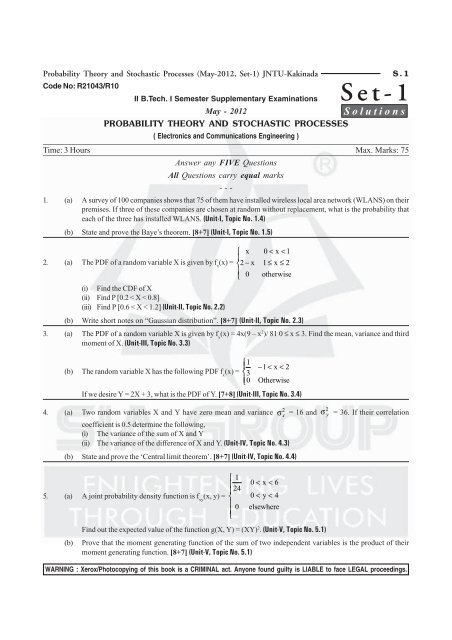
![Set-2 Final by Mudassir [10-22] N.p65 - SIA GROUP](https://img.yumpu.com/50708500/1/184x260/set-2-final-by-mudassir-10-22-np65-sia-group.jpg?quality=85)

![Set-1 Final by Mudassir [1-4].p65 - SIA GROUP](https://img.yumpu.com/49027305/1/184x260/set-1-final-by-mudassir-1-4p65-sia-group.jpg?quality=85)
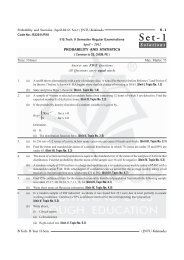
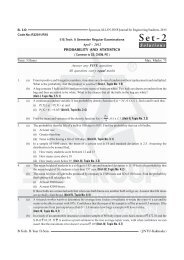
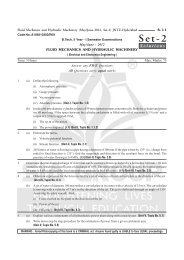

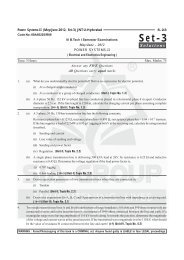
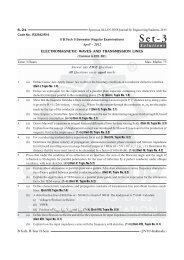
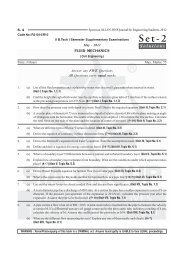
![Set-1 Final by Mudassir [1-16] (M).p65 - SIA GROUP](https://img.yumpu.com/36090047/1/184x260/set-1-final-by-mudassir-1-16-mp65-sia-group.jpg?quality=85)
